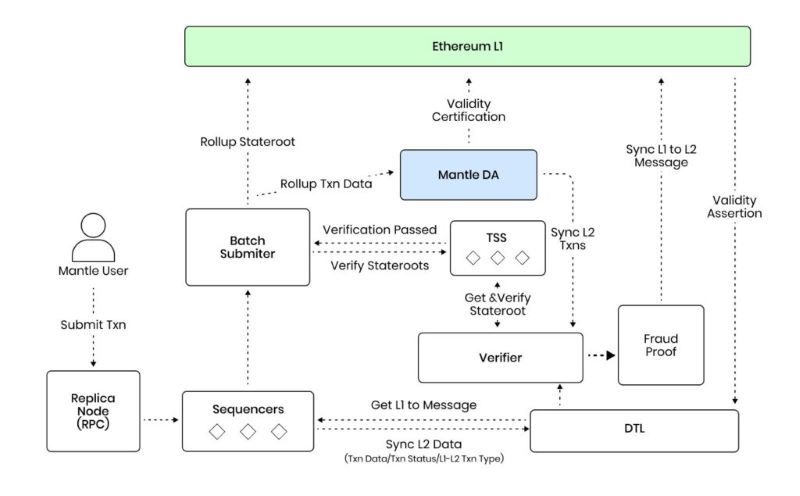Mantle Network is an innovative project that evolved from BitDAO, one of the largest decentralized autonomous organizations (DAOs) globally, supported by Bybit, a major cryptocurrency exchange. Mantle extends the legacy of BitDAO by introducing a cutting-edge Layer 2 solution designed to enhance Ethereum’s scalability and performance. This article explores the unique features and benefits of Mantle Network.
What Exactly is Mantle Network?

Mantle Network is a Layer 2 scaling solution built on Ethereum, using Optimistic Rollup technology. This allows the network to increase the throughput of transactions while maintaining the security of the underlying Ethereum Layer 1. It works by rolling up multiple transactions into a single batch and posting it to Ethereum, which reduces gas fees and speeds up processing.
In addition to scalability, Mantle leverages EigenDA, a data availability layer developed by EigenLayer, which significantly reduces the cost of storing transaction data.
The Core of Mantle’s Modular Architecture
Mantle’s modular design tackles some of the most pressing challenges faced by Layer 2 networks today:
- High Fees: Layer 2 users often face significant fees because Optimistic Rollup posts data directly to Ethereum.
- Limited Throughput: Using Ethereum as a data availability layer limits how much transaction data can be processed by Layer 2 nodes.
- Slow Finality: Optimistic Rollups generally require long challenge periods (up to 7 days) before users can withdraw their funds back to Layer 1.
To address these issues, Mantle Network uses a new data availability model called Mantle DA. This layer allows nodes to provide data storage services while earning rewards through MNT staking, offering a more cost-effective and scalable solution for processing and securing transactions.
Liquid Staking Derivatives: A Mantle Innovation
One standout feature of Mantle Network is its Liquid Staking Derivative product. This enables users to stake ETH on Ethereum through Mantle and receive a token called mntETH, which can be used across Mantle’s ecosystem. Participants not only secure the network but also earn rewards from staking returns, including MEV (Maximal Extractable Value) and network fees.

How Mantle Network Functions
Mantle Network operates with a highly efficient design. Here’s a breakdown of how it works:
- Sequencers collect signed transactions from users, process them, and bundle them into blocks.
- These blocks are synchronized through a Data Transport Layer (DTL), ensuring the data is readily available across the network.
- Once verified, data is published on Ethereum Layer 1, while Rollup Verifiers ensure the validity of the transaction data.
- Threshold Signature Scheme (TSS) Nodes play a crucial role in securing transactions, signing off on state transitions before submitting them to Ethereum.
DA Nodes within Mantle play a crucial role in storing transaction data and ensuring it can be retrieved and verified whenever necessary. This decentralized data storage ensures that the network remains secure and resistant to fraud.
Mantle’s Competitive Edge
Several features make Mantle Network stand out among other Layer 2 solutions:
- Security from Ethereum: Transactions on Mantle inherit Ethereum’s security, making it highly reliable.
- Developer-Friendly: The network supports popular development tools such as Truffle, Hardhat, and Solidity, making it accessible for smart contract developers.
- Low Gas Fees: With data compression and modular design, users benefit from up to 80% reductions in gas costs.
- High Throughput & Low Latency: Mantle offers near-instant transaction confirmation with processing speeds that can reach 500 transactions per second (TPS).
Mantle’s Roadmap and Expansion
Mantle Network’s journey gained significant momentum in May 2024 when BitDAO and Mantle officially merged, a move that followed the approval of the BIP 21 proposal. This merger brought together BitDAO’s governance expertise and financial resources with Mantle’s technological prowess, aiming to build a unified and powerful blockchain ecosystem.
With substantial financial backing, including over $300 million in stablecoins and 270,000 ETH (worth approximately $485 million), Mantle is well-positioned to expand its infrastructure and increase adoption in the future.
MNT Token and Governance
At the heart of Mantle Network’s ecosystem is its native token, MNT. The token serves several essential functions:

- Governance: MNT holders can participate in decision-making processes for the network.
- Transaction Fees: MNT is used to pay for gas fees on the Mantle network.
- Staking: It acts as collateral for node operators, ensuring the security of the network.
MNT tokens have no vesting schedule, meaning their distribution and use are determined through governance votes within Mantle’s DAO.
Mantle Network is shaping up to be a formidable Layer 2 solution, offering advanced scalability and lower costs for developers and users alike. Its modular architecture and Liquid Staking Derivative product set it apart from other Layer 2s, while the backing of BitDAO ensures it has the financial resources necessary for long-term success.
As the Layer 2 landscape evolves with innovations like Superchain (Optimism) and Hyperchain (ZKsync), Mantle is positioned to be a significant player in the next generation of blockchain infrastructure.


